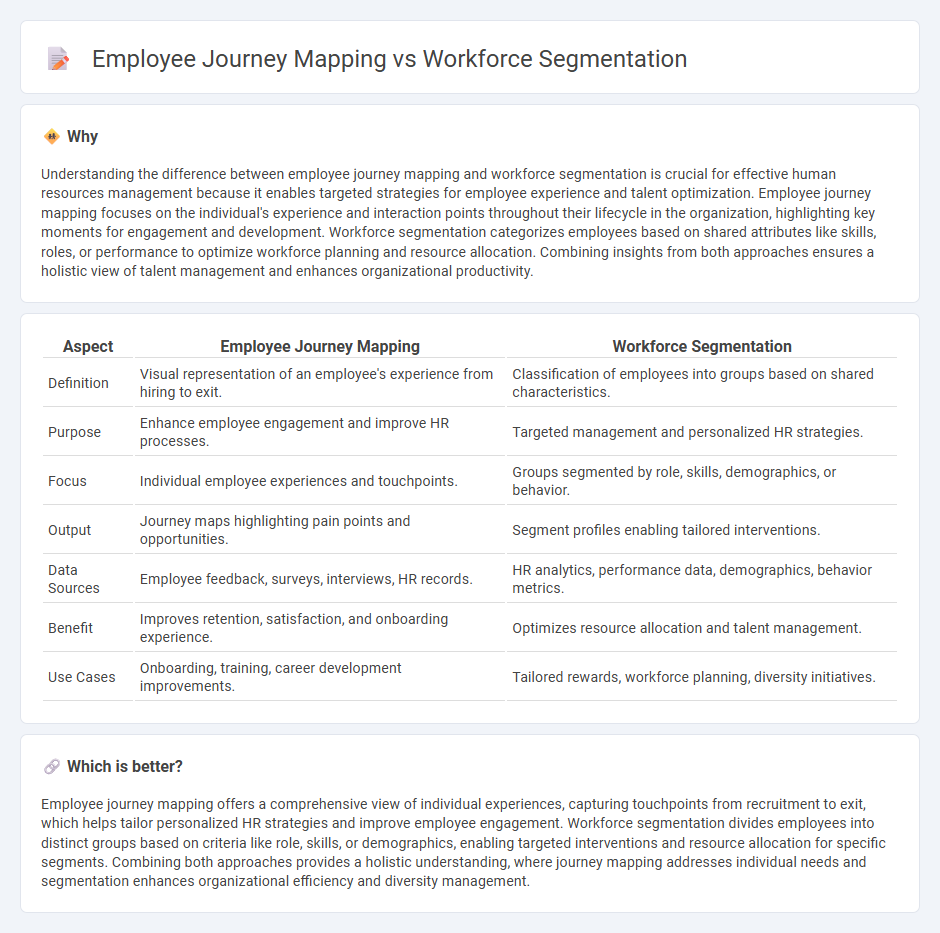
Employee journey mapping captures the sequential experiences and interactions individuals have within an organization, highlighting key touchpoints that influence engagement and productivity. Workforce segmentation categorizes employees into distinct groups based on criteria like skills, roles, or demographics to tailor management strategies and improve resource allocation. Explore these methodologies to enhance talent management and organizational effectiveness.
Why it is important
Understanding the difference between employee journey mapping and workforce segmentation is crucial for effective human resources management because it enables targeted strategies for employee experience and talent optimization. Employee journey mapping focuses on the individual's experience and interaction points throughout their lifecycle in the organization, highlighting key moments for engagement and development. Workforce segmentation categorizes employees based on shared attributes like skills, roles, or performance to optimize workforce planning and resource allocation. Combining insights from both approaches ensures a holistic view of talent management and enhances organizational productivity.
Comparison Table
| Aspect | Employee Journey Mapping | Workforce Segmentation |
|---|---|---|
| Definition | Visual representation of an employee's experience from hiring to exit. | Classification of employees into groups based on shared characteristics. |
| Purpose | Enhance employee engagement and improve HR processes. | Targeted management and personalized HR strategies. |
| Focus | Individual employee experiences and touchpoints. | Groups segmented by role, skills, demographics, or behavior. |
| Output | Journey maps highlighting pain points and opportunities. | Segment profiles enabling tailored interventions. |
| Data Sources | Employee feedback, surveys, interviews, HR records. | HR analytics, performance data, demographics, behavior metrics. |
| Benefit | Improves retention, satisfaction, and onboarding experience. | Optimizes resource allocation and talent management. |
| Use Cases | Onboarding, training, career development improvements. | Tailored rewards, workforce planning, diversity initiatives. |
Which is better?
Employee journey mapping offers a comprehensive view of individual experiences, capturing touchpoints from recruitment to exit, which helps tailor personalized HR strategies and improve employee engagement. Workforce segmentation divides employees into distinct groups based on criteria like role, skills, or demographics, enabling targeted interventions and resource allocation for specific segments. Combining both approaches provides a holistic understanding, where journey mapping addresses individual needs and segmentation enhances organizational efficiency and diversity management.
Connection
Employee journey mapping identifies key touchpoints and experiences throughout an employee's lifecycle, enabling a comprehensive understanding of workforce dynamics. Workforce segmentation categorizes employees based on demographics, skills, and behavior, allowing tailored HR strategies for each group. Integrating these two approaches enhances talent management by aligning personalized experiences with specific employee segments, improving engagement and retention.
Key Terms
**Workforce Segmentation:**
Workforce segmentation involves categorizing employees based on characteristics such as skills, roles, demographics, and performance to tailor management strategies and optimize productivity. This method allows organizations to identify distinct groups for targeted training, engagement, and retention efforts, enhancing overall workforce effectiveness. Explore more to understand how workforce segmentation drives strategic human capital management.
Demographics
Workforce segmentation categorizes employees based on demographics such as age, gender, tenure, and job function to tailor HR strategies effectively. Employee journey mapping, while considering demographics, emphasizes the individual's experiences and interactions throughout their employment lifecycle. Explore how integrating demographic insights enhances both workforce segmentation and journey mapping for optimized talent management.
Skills Analysis
Workforce segmentation classifies employees based on specific attributes such as skills, roles, and performance levels, enabling targeted Skills Analysis to optimize talent management and development strategies. Employee journey mapping tracks the holistic experiences of employees throughout their tenure, highlighting critical touchpoints that impact skill acquisition and growth opportunities. Explore how combining workforce segmentation and employee journey mapping can enhance comprehensive Skills Analysis for improved organizational success.
Source and External Links
What Is Workforce Segmentation? Plus Common Methods - This webpage explains workforce segmentation as the process of dividing employees into groups based on shared characteristics, including role, skill, and geography.
Workforce Segmentation: Types, Benefits, and Steps to Implement - This article discusses workforce segmentation methods like role-based, skill-based, and geographic segmentation to optimize collaboration and productivity.
What is Employee Segmentation? Examples & Models - This blog post describes employee segmentation as categorizing employees based on shared characteristics and needs, enhancing engagement and satisfaction.
 dowidth.com
dowidth.com